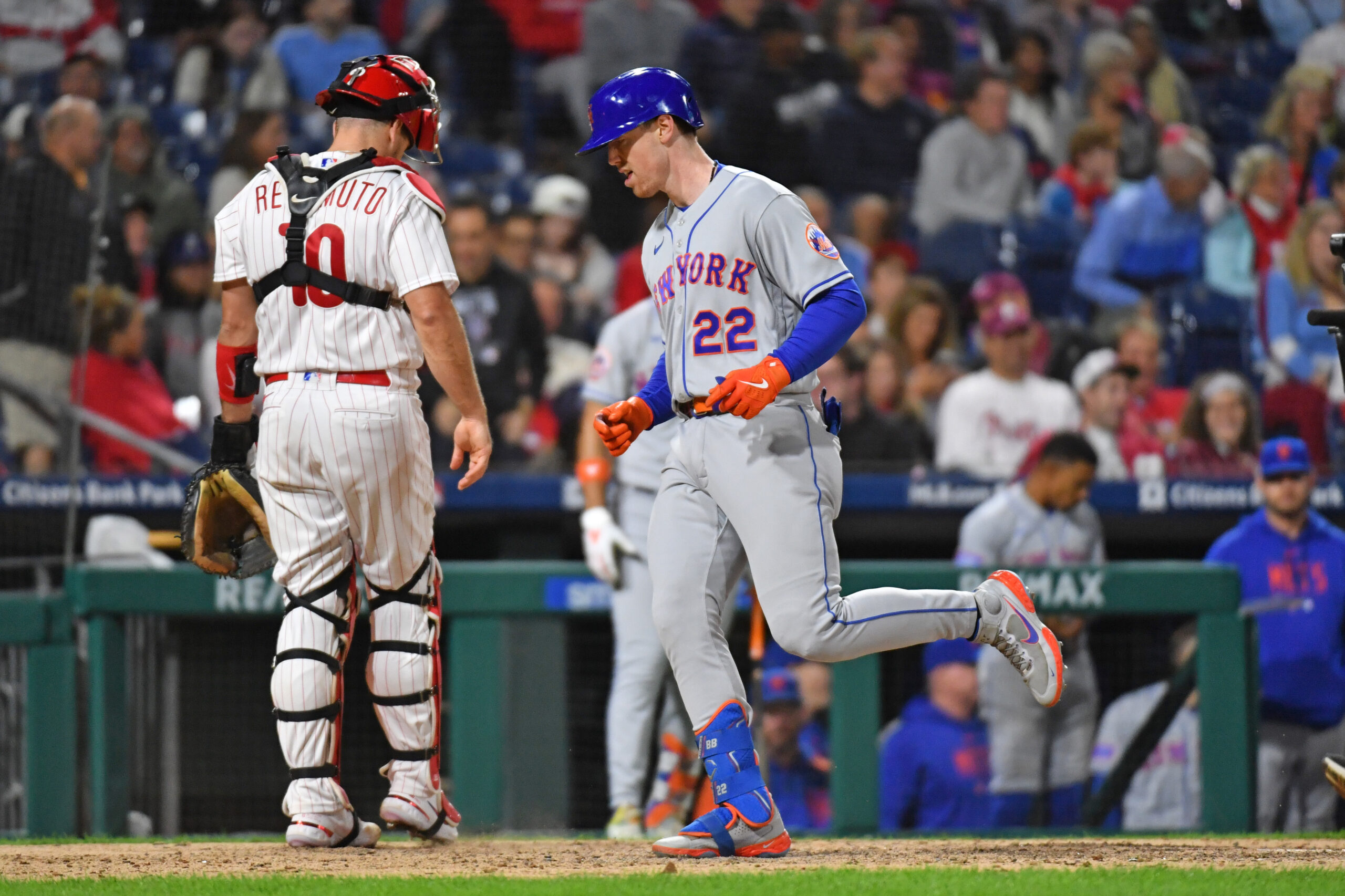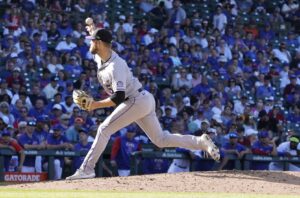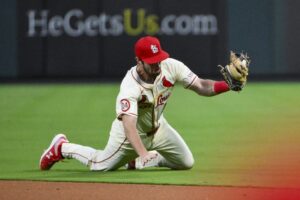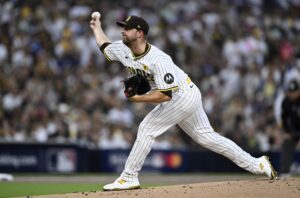The New York Mets third base position has mostly been a black hole since spinal stenosis derailed David Wright‘s career. The underrated star provided two-way stability at the hot corner the team has been missing for several years. While a trio of prospects failed to claim the job this season, all three have impressed with an impressive September.
Mark Vientos, Brett Baty, and Ronny Mauricio are former top organizational prospects that can lock down third base in Queens for the future. While none have reputations as good defenders at the position, they are either blocked at more natural positions or unexperienced in others. A hot finish to a disastrous season will only mean so much to the organization this offseason, but the trio’s performance this month has refueled some hope into their futures.
Third Base is Getting Crowded for the Mets
Even when Baty and Vientos were struggling at the majors and Mauricio was struck in the minors, the Mets were never likely to spend significant resources for third base upgrades this winter. That’s especially true now that the trio of high ceiling, inexpensive youngsters have shown signs of life this September. While none of them will be guaranteed spots on the opening day roster, they all will likely compete for the third base job in the spring.
They all profile as bat-first players, but can each bring unique value to the Mets lineup.
What the Mets need from Mark Vientos
Among the trio, Vientos has been the hottest for the longest. With Baty’s August demotion, Vientos finally received a legitimate extended stretch of playing time. Though he started slow, he’s improved since returning from a quick IL trip.
Since his return, the 23-year-old has hit .263 with six homers and an .818 OPS in 22 games. While Vientos has mashed his way through the minors, his .513 SLG in this stretch represents the first time his power translated at the game’s highest level.
Mark Vientos drives a homer off of Aroldis Chapman pic.twitter.com/GW135gDgqS
— SNY (@SNYtv) August 30, 2023
Underlying metrics indicate that it was just a matter of time before Vientos’ power arrived. If he had enough at-bats to qualify, Vientos would be among the leaders in Average Exit Velocity (93.3 mph) and Hard-Hit Percentage (52.6%). He is finally getting a chance to play every day. In return, he’s showing the ability to provide the team with what they’ve been needing (right-handed power).
At this point, the Mets will be fortunate if Vientos develops into an average defender at any position. Additionally, the Mets might not want a full-time DH next year, let alone one as young as Vientos. However, there is more than enough power in his bat that teams will easily overlook his defensive shortcomings.
Another homer for Mark Vientos, who now has three in his last seven plate appearances. pic.twitter.com/iXxTVsmMus
— Anthony DiComo (@AnthonyDiComo) September 22, 2023
Vientos needs to prove that he can provide consistent right-handed slugging to protect Pete Alonso in the lineup. Darin Ruf failed in the role last year and Francisco Alvarez shined for a couple months this season. However, this power coming from a consistent, non-catcher source will best protect Alonso and greatly boost the lineup. Vientos hitting 25-30 homers in the lower half of the lineup should make up for his lack of defense.
What the Mets need from Brett Baty
Baty’s path to success at the big leagues is no secret. For all his struggles this year, Baty has hit the ball hard and displayed great bat speed. Also, he shows a great approach at the plate when he is at his best.
However, he hit too many balls on the ground and made poor swing decisions during his struggles this year. Both prevented him from getting the most out of his power. The team demoted Baty hoping he would regain confidence and adjust his swing to generate more ideal launch angle.
Players in the Mets Statcast era with a home run of at least 112 mph and 440 feet:
Pete Alonso
Yoenis Céspedes
Brett Baty
Ronny Mauricio— Mike Mayer (@mikemayer22) September 21, 2023
Over his last several games, Baty has two home runs while hitting .368. Although a small sample inflates the batting average, his homers have been long and hard. Additionally, he has successfully gone the other way to collect hits on multiple occasions this month. This small sample-size success does not guarantee Baty a job or success in 2024. However, it does give reason to hope that Baty regained confidence and feel at the plate that should lead him to fulfill his potential.
Brett Baty just demolished a game-tying homer off Phillies closer Craig Kimbrel with one out in the ninth inning at Citizens Bank Park. 110 mph off the bat, 432 feet, Baty's second homer in three games. pic.twitter.com/5oeuddmUIO
— Anthony DiComo (@AnthonyDiComo) September 23, 2023
Like Vientos, Baty’s career depends on his bat, not his glove. Despite -4 Outs Above Average this year, Baty projects to be better than Vientos and can even develop into above average. If J.D. Davis can make great strides defensively at third, so can Baty.
Although the Mets want Baty to tap into his power more, he has the potential to be more than just a slugger. He can be a blend of Brandon Nimmo, Jeff McNeil and Francisco Lindor in one package. Baty profiles as capable of hitting .280 with 25 homers and 25 doubles while taking great at-bats. This all-around offensive producer fits most lineups, but can protect the team if Nimmo doesn’t continue hitting with power as he ages.
How does Ronny Mauricio factor in the third base mix?
If Mauricio sticks with the Mets, he won’t be playing his natural position of shortstop. Multiple Mets front office regimes resided over an organization with Mauricio in the minors and Lindor signed longterm. However, Mauricio only started playing a non-shortstop position midway through this season.
While it’s unclear whether he fits best at third base, second base, or in the outfield, his position will likely depend on others on the roster. If Baty or Vientos earn playing time at third, Mauricio will likely play second with McNeil moving to the outfield.
#MetsReport – Ronny Mauricio stays with the play and make a hard throw to get Joey Meneses out 😮💨🔥 #LGM pic.twitter.com/ZSXeqgHHzF
— Top Bunk Sports (@Topbunksports) September 6, 2023
Despite only being called up on September 1, Mauricio has earned 1 Outs Above Average at second base in 138.1 innings. He has -2 OAA in 35.2 innings at third. However, Mauricio has the opportunity to claim the third base job if the other two underperform in Spring Training or have rough starts to the regular season.
While the 22-year-old has power, he brings a more athletic and dynamic skillset that the Mets don’t currently have elsewhere. The tall and lankly speedster has already shown an ability to not only steal bases, but take advantage of sloppy defense.
An ELECTRIC trip around the bases with Ronny Mauricio ⚡ pic.twitter.com/URB6XFPiKF
— SNY Mets (@SNY_Mets) September 23, 2023
It will be interesting to see what the Mets do this offseason. The roster can improve at second base or left field (depending on where McNeil plays). However, a weak free agent class might not offer guaranteed upgrades. Baty and Vientos are more or less locked into third base, but Mauricio’s flexibility allows the Mets to act creatively when acquiring players this winter.
How will third base impact the Mets in the offseason?
General manager Billy Eppler constructed the 2023 roster expecting contributions from some combination of Baty, Vientos, and/or Mauricio. The fact that all three will enter another season with question marks might represent the biggest disappointment from this year.
Young Mets should earn playing time. However, the organization lacks a great reason to keep these players in Syracuse next April. They need extended run in the majors to showcase whether or not they can contribute. Baty and Vientos both overcame struggles to perform well in September. Mauricio, despite the late call up, impressed with his tools while playing almost every day.
The Mets need to learn what they have in these players, especially if the team refuses to trade them. With better prospects scheduled to debut in late 2024 and 2025, the time to evaluate Baty, Vientos, and Mauricio is as soon as possible.
It hasn’t gone unnoticed by Mets officials that Brett Baty’s recent surge has occurred after Ronny Mauricio performed well at third base for a stretch of games. Competition can be a good motivator.
— Mike Puma (@NYPost_Mets) September 23, 2023
While September stats famously don’t mean much, these players have opened many eyes with their play. Although one can make a case in favor of trading one of the trio for pitching help, the Mets will likely keep all three this winter. Their good performance down the stretch this season earned them a longer leash in the organization’s plans for the future. Third base might be the best fit for all three, yet only one man can play at a time. Competition should bring out the best of them.
Main Photo Credits: Eric Hartline-USA TODAY Sports






